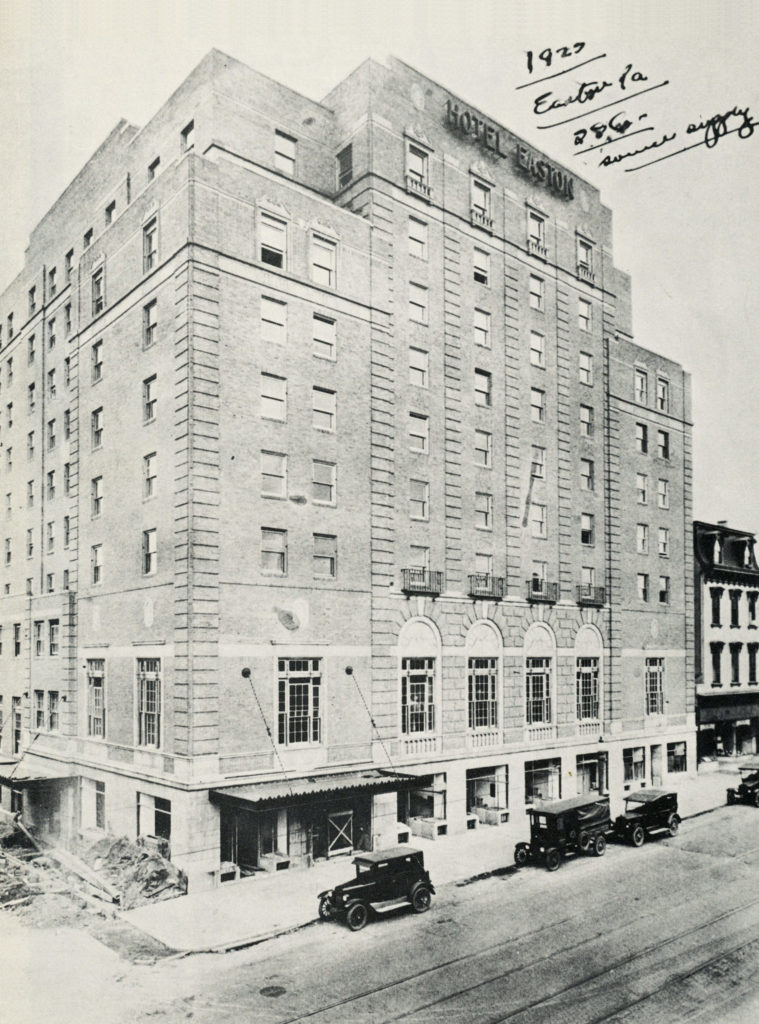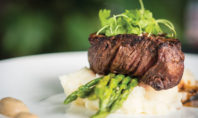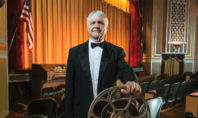Grand Eastonian
 When the rather prosaically named Hotel Easton opened its doors on February 10, 1927, visitors discovered a hostelry that was anything but prosaic.
When the rather prosaically named Hotel Easton opened its doors on February 10, 1927, visitors discovered a hostelry that was anything but prosaic.
Designed by Philadelphia architect Thomas, Martin & Kirkpatrick, the Hotel Easton towered a full 10 stories above street level, and combined modern forms with classic architectural styling.
According to then-contemporary reports, the hotel’s opening night was a true extravaganza – with a live orchestra, four-foot-high floral creations housed in urns of sculpted ice, and uniformed ushers and waiters gliding though the premises while over 400 guests partied until the wee hours.
Local newspapers called it a “brilliant affair”… “the most picturesque event ever held in the City.”
Early years
For a half-century, the Hotel Easton lived up to its billing as a keystone of downtown life. It bustled with weddings, conferences and political events, and served as a temporary home for everyone from ordinary business travelers to celebrities of the day.
Its guest list included Eleanor Roosevelt (who served as First Lady from 1933 to 1945), boxing legend Jack Dempsey, cigarette manufacturers Phillip and Johnny Morris and campy singer Tiny Tim. John F. Kennedy and Jesse Jackson were among the political notables who spoke there.
Hard times
The hotel’s heyday lasted into the 1970s. But as an economic malaise gripped the region, the hotel – and many other businesses – began to decline.
Rooms stayed empty, revenue streams dried up. The former crown jewel of downtown Easton eventually cast only a pale shadow of its original splendor. Finally, the hotel’s owners conceded defeat and filed for bankruptcy in 1989.
Its demise happened so quickly that, for years, patrons’ unfinished drinks remained on the bar and unmade beds remained rumpled or bare.
The unkempt façade sent a silent message: “Easton is falling apart.” And that wasn’t a good message to send to the neighborhood, to visitors, or to potential new businesses.
Plans for resurrection
The increasingly shabby building remained derelict for over a generation. But in 1992, then-Mayor Thomas F. Goldsmith made reclamation – rather than destruction – of the former landmark one his administration’s top priorities.
Why not just raze the eyesore? “The hotel had been an important part of Easton for many years,” said Jane Stanley, president of Easton Hotel Restoration, LLC (EHR). “It imparted a big sense of history, and Mayor Goldsmith wanted to maintain that.”
Goldsmith’s efforts – assembling potential grants, creating a Keystone Opportunity Zone as a tax incentive – to find a buyer or developer for the property continued through the ‘90s, with no success.
That is, until the Nurture Nature Foundation entered the picture. Goldsmith had approached the non-profit group, which is dedicated to addressing environmental issues, and found that it viewed the preservation of old buildings as “the ultimate recycling project.”
The foundation formed Easton Hotel Restoration as a subsidiary which acquired the property in 2000. The original goal was to maintain its use as a hotel – but regulatory changes soon scotched that idea.
“One condition on using it as a hotel was the inclusion of a parking lot that would meet government regulations,” Stanley said. “And we expected financial contributions from the city and state” to help defray the costs.
Time for Plan B
But after years of waiting for those funds, “We eventually assumed they were not coming through, so we developed an alternative plan,” she said. The hotel’s 175 rooms would be converted to 30 apartments, and the lower-density use would rectify the parking problem.
The ambitious conversion project began in 2004. Directed by architect William Dohe, “We gutted nearly the entire building,” Stanley said. Only the original exteriors, entrance – including the staircase and lobby – the Gold Room were saved. Spacious suites, ranging in size from 873 square feet to nearly 3,000 square feet, were created practically from scratch.
After a $13 million investment, the condos went on public sale on June 26, 2006 – the same day the nearby Delaware River overflowed its banks and flooded Easton. The lower level of the hotel, including a good part of the basement, was severely water-damaged. A national economic slump created a double-whammy, and condo sales ground to a halt.
Clearly, yet another solution for the building’s woes was needed.
Going full-circle
After much deliberation, EHR reverted to the original hotel concept, but retained the current condo suite design.
Another half-million-dollars from NNF went toward furnishings and appliances, a full communications system, security cameras and other necessary materials. After five months, the building re-opened in its current incarnation, the Grand Eastonian Suites Hotel.
It offers single rooms, and suites with one to three bedrooms that feature wood floors, beamed ceilings, a fitness center, indoor pool, salon/day spa and much more, all on-site.
Although EHR expected mainly long-term guests, the opposite has proven true. “We provide lodging to far more day-to-day visitors,” Stanley said. “During the week, we see many corporate travelers who might be in the area for a meeting.
“And on weekends, our visitors are often attending Lafayette sports, or visiting the campus. We also can host various meetings, graduations, wedding parties, reunions – even funeral receptions,” she added.
And just as the original Easton Hotel was “home” to traveling celebrities, the Grand Eastonian is regularly occupied by performers at the State Theatre Center for the Arts.
After nearly 90 years, the former Hotel Easton has been through a lot – from thriving success to financial failure, and back again. And in a time when grand old buildings are often flattened to make room for new glitz and glamour, the brick-and-limestone Grand Eastonian has prevailed.
For more information about the hotel visit grandeastoniansuiteshotel.com or call 610.258.6350.













